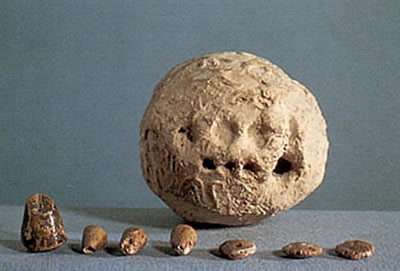|
#1 World's first essay |

|
| Sumerian
"tokens," from Susa, Iran, about 3300 B. C., now housed in the Louvre
Museum. Tokens were a form of data storage or transmission. The hollow
clay ball—the essay!—contained the tokens (foreground), with
symbols stamped and punched on the outside indicating the contents inside.
The tokens inside probably represented different counts. The larger cone
here might have stood for so many measures of grain. Clearly this is an
advanced essay, no doubt from a technical writing course—a set of
instructions with introduction and seven paragraphs.
Well, that's my fanciful take. If you are looking for a more scholarly position on tokens and the evolution of written language, consult Denise Schmandt-Besserat, who is the leading expert on the subject. For starters, try "Two Precursors of Writing: Plain and Complex Tokens," in Wayne M. Senner (Ed.), The Origins of Writing; Lincoln, NE: University of Nebraska Press (1989), pp. 27-42. Or if you want it all in one glossy, beautiful coffee-table book, replete with photographs and diagrams and a fold-out, see Schmandt-Besserat's Before Writing (Volume I): From Counting to Cuneiform; Austin, TX: University of Texas Press (1992). The humble illustration above, however, is from Hartmut Gunther and Otto Ludwig (Eds.), Schrift und Schriftlichkeit, Vol. I (Berlin: Walter de Gruyter, 1994). RH, January 2003 |